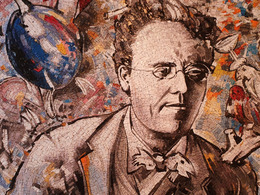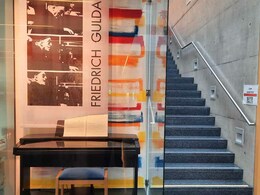Gustav Mahler mosaic by Christian Ludwig Attersee & Friedrich Gulda showcase



- All weather
- Suitable for groups
The "holiday composer" Gustav Mahler is depicted in a mosaic based on a design by Prof. Christian Ludwig Attersee. Mahler spent his summers from 1893 to 1896 at the Hotel-Gasthof Föttinger in Seefeld am Attersee. He had a composer's cottage built in which some of his works or parts of them, such as the 2nd and 3rd symphonies, were composed.
Another important Steinbach resident is the pianist Friedrich Gulda, who lived in Steinbach am Attersee for a long time and found his final resting place in the Steinbach cemetery. In the display case you can see Gulda's Clavinova, original sheet music and portraits of the musician.
You can view this successful example of art in public space during the opening hours of the office building. Combine it with a visit to the Gustav Mahler Composer's Cottage in Seefeld or the Steinbach parish church. Find out more about the artistic personalities on the Artists' Trail in Weißenbach am Attersee.
The following text by Anna - Maria Eder offers a deeper insight into the topic:
The artists in the centre
The art in the public space of the village centre in Steinbach am Attersee honours the artists in a multi-layered, multifunctional sense. The foyer of the community and service centre cleverly combines the space of information behind the glass with the space of a representative entrée. It comes as no surprise that two important artistic personalities are thematised in the foyer and presented in two different ways. The musicians and composers Friedrich Gulda and Gustav Mahler are both connected to the town in a special way.
Gustav Mahler spent the summers of 1893-1896 as a so-called "holiday composer" in Steinbach. The sought-after conductor was working in Hamburg at the time and used the summer months to spend time with his siblings in the tranquil countryside. He set up a composer's cottage next to the Föttinger inn, where he lived. He retired there to compose his second and third symphonies. He roamed the woods and observed nature, of which these symphonies are a vivid testimony. He once said to Bruno Walter, who looked up at the Höllengebirge in shock and awe: "You don't need to look at it any more. I've composed everything away"
The foyer is characterised by its openness, glass walls from the outside to the inside, a glass wall between the foyer and the information department. The display case for Friedrich Gulda is made of glass, a small museum-like space: enclosing, protective. It is designed by the textile artist Elke Salzmann. She has been active for 10 years as an entrepreneur of "Tex Art", which offers textile objects with additional benefits - textiles for acoustics, as room dividers, light protection or for orientation. In this case, the showcase contains Friedrich Gulda's original Clavinova, which is displayed on the one hand, with the option of taking it out of the museum's protected zone and playing music on it. The versatile Friedrich Gulda, pianist, musician, composer, from classical to jazz, performer and enfant terrible loved this new electric piano, which in addition to the piano sound also had a variety of other "registers", including perfectly acceptable oboe, percussion, harpsichord, lute and string sounds.
Gulda says: "It was a great help for me to receive messages and instructions from the living spirit of Mozart". Textile flags for space and background design, as information carriers and image carriers: in three black-and-white photos by Hans Zechmeister, Gulda is depicted as a pianist: once strictly, once concentrated and once enthusiastic. The other flag has a horizontal colour scheme in yellow, red and blue
"colour tones" to indicate the musical colourfulness. Colour in life through music through and through. The art remains alive, the music remains alive, the memory of this person remains alive. This unconventional artist of "liberated" sounds, Friedrich Gulda, lived here for over 20 years until his death and is also buried in Steinbach.
Gustav Mahler conquered the rock, the mountains of hell, with his music. At his side is the artist Christian Ludwig Attersee, who has placed two portraits of the conductor, musician and composer as a mosaic in the public space. Ingeniously cladding a lift shaft, two large-format painted portraits of Gustav Mahler from 1997 have been used as a template - as a day side and an after side, as the titles indicate.
He sifted through 250 Mahler photos in black and white and then developed "his" portrait - day and night, two facets of a portrait from 1907, which was photographed in the Court Opera House A look at the programme of the symphonies shows how much Attersee is involved with the symphonies composed in Steinbach. The second symphony is called the Resurrection Symphony after a poem by Klopfstock, in which the vision of the primordial light is set to music in the same way as St Anthony's sermon on fish. Mahler writes "Pan awakens. Summer marches in". The programme of the individual movements makes audible "what the flowers in the meadow tell me", as well as the animals in the forest, man, angels and love. Friedrich Nietsche's "Nachtwandlerlied" from Zarathustra is also included.
While the second symphony is dedicated to man and his divine redemption, the third symphony goes one step further and opens up to the totality of creation.
Christian Ludwig Attersee takes up many of the musical narrative motifs. He, himself a gifted inventor and transformer of objects, has inserted Gustav Mahler into his lively, animated world, in which one thing constantly transforms into another, one thing grows into the next. His picturesque world consists of wind and water, in the eternal journey of the master sailor, but also of the musician. Everything sounds, everything buzzes in his dynamic, explosive style. Since 1966 he has declared himself bound by name to the Attersee as the state of being of his art and his person.
A weeping envelope, his mesh tied around his neck becomes a fish. A small goat stands on the suit like a child's toy.
Cut branches sprout from his head, outgrow his body. Thoughts branch out, are pruned, inhibited?
Attersee declares himself a buttock fetishist when asked about a naked buttock immersed in the mists of the night blue, and then quite unconcernedly: "Everyone was naked as a child. Everyone was happy as a child. He deliberately presents him with objects of childlike lust and joie de vivre: dancing red cherries, an oversized plum, a fish in the water balancing a house, a flying tie, a cross, a heart, birds and flowers fill the room. The mysterious northern lights flicker. The impasto colour application of the painted pictures, the brushstroke is transferred to the stone setting. A special transformation: music - painting - mosaic
Anna Maria Eder Salzburg/ Roman Höllbacher, Salzburg
The mosaic can be visited during the opening hours of the tourist office and the village canter.
- Saturday
- Sunday
- holiday
Car:
From Vienna/Linz via the A1 - Schörfling am Attersee exit - then another 17 km via the B 152 Weyregg am Attersee to Steinbach am Attersee.
From Salzburg via A1 - exit Mondsee - then another 25 km via Unterach am Attersee - Weißenbach am Attersee to Steinbach am Attersee
From the north via the A8 - Ried exit - to the town of Ried approx. 4 km, then another 60 km via Frankenburg - Gampern - Schörfling am Attersee - Weyregg am Attersee to Steinbach am Attersee
From the south via Bad Ischl - from Bad Ischl there are still 25 km - after about 4 km turn left - across Weißenbachtal to Attersee - in Weißenbach am Attersee turn right to Steinbach am Attersee
By train:
Coming from Vienna/Linz/Wels to Vöcklabruck or Attnang-Puchheim and continue by bus or cab to Steinbach am Attersee.
From Salzburg to Vöcklabruck or Attnang-Puchheim and continue by bus or cab to Steinbach am Attersee or alternatively BHF Vöcklamarkt and take the Atterseebahn to Attersee - continue by boat to Steinbach am Attersee
Plane:
W. A. Mozart Airport Salzburg on the A1 until exit Mondsee to Steinbach (approx. 60 km)
Blue Danube Airport Linz on the A1 until exit Schörfling and via the B152 to Steinbach (approx. 90 km)
- Parking space: 10
- Toilet facility
- Playground (outdoors)
Café-restaurant SEE YOU
Entrance is free of charge!
- All weather
- Suitable for groups
- Suitable for schools
- Spring
- Summer
- Autumn
- Winter
Please get in touch for more information.
Contact
4853 Steinbach am Attersee
Phone +43 7666 7719 - 60
E-Mail info.steinbach@attersee.at
Web attersee-attergau.salzkammergut.at
Web www.steinbach-attersee.at
http://www.steinbach-attersee.at
You can also visit us on
Visit us on Facebook Visit our videochannel on YouTube WikipediaContact person
Tourismusverband Attersee-Salzkammergut
![[Translate to Englisch:] Foto: Logo TVB Attersee-Attergau](/fileadmin/_processed_/7/a/csm_Destinationslogos-Attersee-Attergau-web_50de931c02.png)







